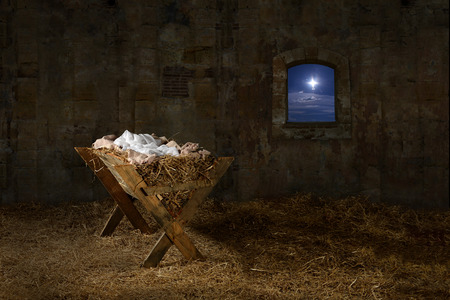 “And [Mary] gave birth to her firstborn son. She wrapped him in swaddling clothes and laid him in a manger, because there was no room for them in the inn” (Lk 2:7)
“And [Mary] gave birth to her firstborn son. She wrapped him in swaddling clothes and laid him in a manger, because there was no room for them in the inn” (Lk 2:7)We know the account of Jesus’ birth so very well, and the almost tangible atmosphere penetrating these familiar words. If we think about it, we soon discover that what we’re sensing, relayed so clearly in Saint Luke’s economy of language, is the unmistakable air of poverty.
The Catechism of the Catholic Church reminds us, “Jesus was born in a humble stable, into a poor family ….. In this poverty heaven’s glory was made manifest” (525). The dichotomy of poverty versus heavenly glory, the glory of God Incarnate, offers plentiful food for reflection in Advent, that special time of waiting during which the Church “makes present this ancient expectancy of the Messiah” (524).
Advent is the perfect time to meditate with greater care on the poverty into which our Savior was born, beginning with a closer look at one aspect of the Christmas story which even young children can identify—the manger.
Unlike the familiar freestanding wooden receptacle in the typical Nativity setup, the Infant Jesus’ first bed may have been a ledge carved into rock in a cave, or an animals’ feeding trough of clay and stones, mixed with mud hardened when dry — not exactly a cozy crib. Still, Mary and Joseph would have adapted the manger as their extremely limited resources allowed; fresh straw would have made a clean, dry cushioning bed for the Holy Infant.
Approaching the Christmas manger from a spiritual angle, we can ponder a deeper question: how best to use the season of Advent to fashion a suitable place in our hearts where our newborn Savior can enter and remain. How can we emulate Mary and Joseph, making the manger of our hearts a warm, welcoming receptacle for Jesus? This is a question we can consider from both child and adult perspectives.
When asked how we can make the manger of our hearts a fitting resting place for Jesus during Advent, some modern-day children offered their ideas, both spiritual and practical.
Spiritual suggestions included faithful attendance at Mass, going to confession, praying for others, and volunteering time to work for their parish, such as greeting people arriving for Mass.
On the practical level, suggestions included running food drives and fundraisers like bake sales and lemonade stands, with proceeds donated to charity. At home, doing chores (the first time asked!) vied for star billing with sibling-related issues — taking turns with a younger brother, not fighting with an older sister, sharing toys with a younger sister.
The children’s goal would be the ideal manger, one they described as soft, comfortable, cozy, warm, and safe.
Admittedly, the question for adults is more complex. The pervading tendency to commercialize the season, and to let the resulting stresses steer us off our spiritual course, can only produce a manger which is cold, hard, and unwelcoming. How do we simplify things to achieve that childlike ideal crib of warmth and comfort?
There is also the question of space. If we allow our hearts to become overcrowded with superficial cares; if shopping, decorating, baking, and entertaining preoccupy us totally, how can there be any room left for the guest of honor’s bed once all the seasonal distractions have taken up residence?
Another consideration: youngsters take their cue from the adults in their lives. If parents focus mainly on secular concerns, children also will consider them most important. Maybe things can be re-prioritized this year. Taking time to discuss the Nativity story can lead to helping children make a simple manger. Strips of paper or straw can be added to your manger daily, one piece for each loving act. As the manger fills (hopefully quickly!), children can visualize the preparation of their hearts to welcome the Christ Child.
On the adult level, attendance at Advent weekday Mass or Adoration, even once weekly, can enhance our spiritual efforts greatly. At home, we can make a bit of quiet time to spend with Mary and Joseph, reflecting on her preparations for Jesus’ birth and his concerns for the uniquely precious family entrusted to his care. Online and print resources provide brief reflections on daily Scripture readings; a few minutes invested each morning can shine a whole new light onto a busy, distracting day. Visits to area churches to view different Nativity representations can generate family discussions. Interior mangers can’t help but benefit from such small investments of time and attention.
This Advent season can be a memorable, meaningful time, not for bargains bought or cookies baked, but for the simple beauty and comfort of a very special manger — the manger we fashion in our hearts. In the holy stillness of Christmas Eve, as our families gather around Nativity scenes prominently displayed, we can welcome our Savior into that truly personal, loving manger of our own creation. There Jesus will find the only opulence He desires.
Let every heart prepare Him room!
“And the Word became flesh and made his dwelling among us” (Jn 1:14)
© All Rights Reserved, Living His Life Abundantly®/Women of Grace® http://www.womenofgrace.com
